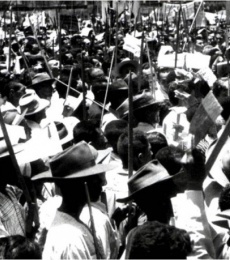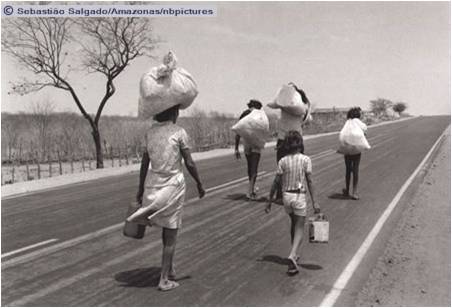Need and Basis for Agrarian Reform
Land Reform Averted
 Rural/ urban migration in the early 1960s helped to fuel a land reform movement, the Ligas Camponesas (Peasant Leagued), led by Francisco Juliao. President Joao Goulart sided with the Ligas– and was deposed by a military coup. For 24 years, the military government largely pushed industrialization.
Rural/ urban migration in the early 1960s helped to fuel a land reform movement, the Ligas Camponesas (Peasant Leagued), led by Francisco Juliao. President Joao Goulart sided with the Ligas– and was deposed by a military coup. For 24 years, the military government largely pushed industrialization.
The Military Dictatorship
The military dictatorship in Brazil (1964-1985) brought profound changes to the country. As a result of the rapid industrialization and mechanization of agriculture, millions of rural Brazilians moved to the urban areas.

This resulted in Brazil being one of the most urbanized countries in the world:
§ Brazil had an urban index of 15% in 1940, 36% in 1950 and 82% in 2006 – 4th most urbanized country in the world
§ 157 million out of a total population of 188 million lived in urban areas in 2006
§ 64% of Brazil’s poor live in urban areas, over 18 million people
§ Almost 7 million urban dwellers lack a water supply and over 20 million lack sanitation coverage
Source: 2000 Brazilian census
By the late 1970’s the social movements – labor, student, agrarian – had organized tremendous opposition to the dictatorship. Strikes in the automobile industry were widespread and the social unrest increasing. The dictatorship ultimately saw the handwriting on the wall and Brazil adopted a new constitution in 1988 at a time when the social movements were strong and could exert a profound influence.
Brazilian Constitution
The Brazilian constitution requires land serve a social function. [Article 5, Section XXIII.] As such, the constitution requires the Brazilian government "expropriate for the purpose of agrarian reform, rural property that is not performing its social function." [Article 184.]
According to Article 186 of the constitution, the social function is performed when rural property simultaneously meets the following requirements:
§ Rational and adequate use;
§ Adequate use of available natural resources and preservation of the environment;
§ Compliance with the provisions which regulate labor relations; and
§ Exploitation which favors the well-being of the owners and workers.
This article provides the basis for the MST’s program of agrarian reform.
Need for Agrarian Reform
Land Concentration
Brazil has the second highest concentration of land ownership in the world. This table shows that latifúndios (large estates – plantations) control 46% of the Brazilian land area.
Percent of Total Farms Percent of Land Area
Farms Under 10 Hectares
(24.7 Acres) 30.4% 2.7%*
Farms Under 100 Hectares
(247 Acres) 89.1% 20%
Farms Over 1,000 Hectares
(2,471 Acres) 1.6% 46%
Source: 1996 Brazilian census
Wealth Inequality
§ 5,000 families (less than .01% of the population) control 40% of Brazil’s national wealth
§ 10% of the population controls 75% of the national wealth
§ 90% of the Brazilian people own less than 25% of the wealth
Source: Professor Márcio Pochmann, Institute of Economics, State University of Campinas
Need for Agrarian Reform
§ 4.6 million landless families living in conditions of extreme poverty and distress
§ 55,000 rural properties (300,000 acres) classified as unproductive
